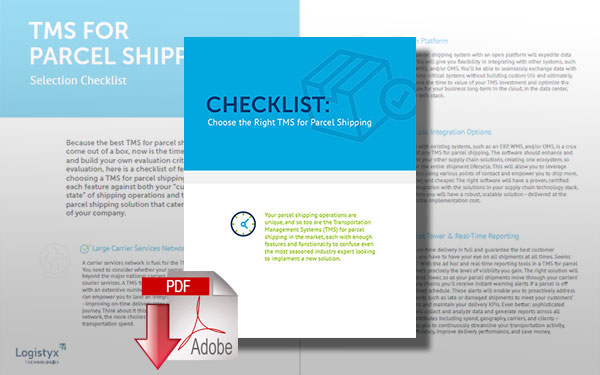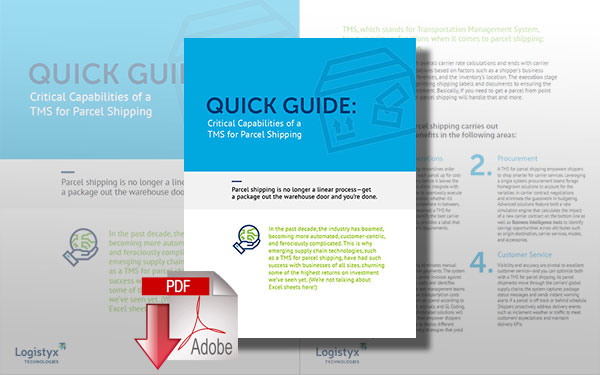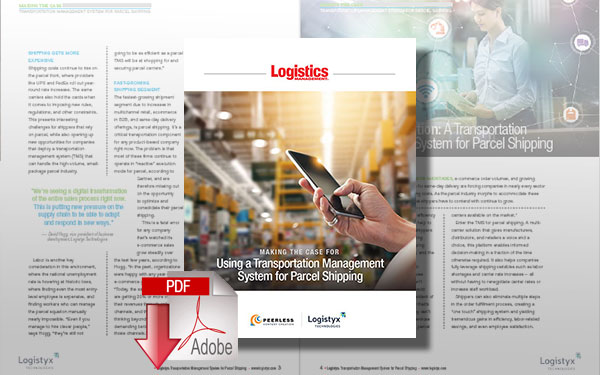3 Ingredients for a Successful Parcel Shipping Solution

With the right parcel shipping strategy and technology in place, you can establish the foundation you need to deliver superior customer experiences...at manageable costs.
Logistics of Parcel Shipping
Parcel shipping is hard. There’s a lot of “stuff” standing between your customers and their purchases, and the roller coaster of events that can take place between a carrier pick-up and delivery is enough to make the most seasoned customer service professional consider running for the door.
Even harder: at the exact moment your parcel shipping is growing more complex, your competition is getting fierce.
Today, there are zillions of buying channels your customers can access to purchase products just like yours, some of which offer myriad shipping options – often free of charge.
This means there’s no time to wait. You have to work now to minimize the “stuff” between your customers and their purchases, and shape positive and consistent buyer experiences.
Plus, you have to communicate really well, telling your customers where their product is at each and every stage in the delivery journey. It’s no easy feat, especially if your internal teams lack the necessary tools and technology to align with your carriers.
But with the right parcel shipping strategy and technology in place, you can establish the foundation you need to deliver superior customer experiences – at a palatable cost to you. You can create a parcel shipping ecosystem that promotes productivity and empowers your internal teams and your carriers to work together — better, cheaper, and faster.
The Right Resource
To achieve cost-effective parcel shipping, you need to provide your shipping teams with the resources they need to efficiently increase profits per shipment. First on this list is parcel shipping technology, which will drive strategic carrier service selection, help you secure advantageous carrier contracts, and enable you to support your customers throughout their buying journey.
More specifically, parcel shipping technology removes traditional barriers between your internal procurement, logistics, finance, and customer service teams and your external software and carrier partners.
For example, parcel shipping technology can alleviate inefficient carrier invoice reconciliation processes or enable your customer service team to proactively send a customer a delivery alert. It’s about empowerment, automation, and orchestration, which lay the groundwork to help you ship more products across farther distances – cheaper and faster.
3 Ingredients for a Successful Parcel Shipping Solution
On the surface, parcel shipping technology is relatively straightforward. Implement parcel shipping technology that automatically selects the best carrier service for each parcel shipment according to your business rules and print the label.
But, as we know all too well, to squeeze the most profit out of every shipment, you have to go beyond printing the label – integrating your technology with your business-critical systems to leverage business intelligence cross-functionally, measure performance, and react quickly. And this is more challenging.
With that said, there are three ingredients — integrations and Professional Services, technology, and Business Intelligence — that are foundational to any successful parcel shipping solution implementation. Here’s what goes into this winning trifecta:
1. Integrations and Professional Services
Despite the impressive functionality in most parcel shipping technology solutions, critical to your success will be how well the technology integrates with both your carriers’ systems as well as your ERP, WMS, OMS and/or e-commerce systems.
You need a solution provider with significant integration experience across a broad network of global carriers and world-leading enterprise, e-commerce, and supply chain software providers – in either a blackbox or attended environment.
You also need a Professional Services team capable of evolving your technology instance as your shipping strategy becomes more complex, that’s willing to coach and train your people.
You need folks who have your back and on whom you can rely to spearhead the conversation that moves your shipping strategy forward. And you need people that know how to leverage and inform the implementation and integration processes and technologies that streamline your shipping workflows and make distributing and managing your shipping data easier. The list goes on and on, but you get the gist — Professional Services are key.
2. Technology
As your organization matures, your distribution scenarios will likely become more complex. This means there will be more shipments, more carrier services, more warehouses, and more information to manage. Technology can help streamline every stage from carrier services procurement to carrier invoice reconciliation and reporting.
For example, the right parcel shipping technology automates carrier selection, produces all necessary labels and documentation, and helps organizations scale and improve their shipping efforts – even across borders.
It gives Customer Service teams 24/7, on-demand access to critical delivery event details, and its dashboards display KPIs such as Total Shipments, Exceptions, Packages In-Transit, Delivered, Late, and Lost. It automatically compares carrier invoices against expected transportation costs and reports on spend according to geography, business unit, accruals, and GL Coding, to name a few.
3. Business Intelligence
A huge part of achieving cost-effective parcel shipping has to do with the creation, distribution, and management of information. While it’s a somewhat vague term, “information” includes everything from delivery event alerts and carrier service scorecards to rate simulations, cost accounting, and more.
Without accurate information and the proper management of it, your organization will have a harder time securing favorable contracts with carriers. Parcel shipping technology with a Business Intelligence platform will understand how factors such as distance, speed to delivery, density, and package size affect spend within the transportation carrier landscape, and analyze your shipping data in real-time to visualize how and where changes should occur for you to yield greater returns.
Put the Right Resources into Action for a Successful Parcel Shipping Solution
Parcel shipping today is challenging. It’s an on-demand, 24/7, obstacle-ridden environment. And you must keep pace. Parcel shipping technology can provide you with the necessary foundation to bridge the great product discovery-delivery divide and help you move your business forward. Wondering which parcel shipping technology is right for you? Here’s how to choose the right parcel shipping technology for your organization.
Related White Paper
Choose the Right TMS for Parcel Shipping
Your parcel shipping operations are unique, and so too are the Transportation Management Systems (TMS) for parcel shipping in the market, each with enough features and functionality to confuse even the most seasoned industry expert. Download Now!
Critical Capabilities of a TMS for Parcel Shipping
Parcel shipping is no longer a linear process - get a package out the warehouse door and you’re done. Download Now!
Using a Transportation Management System for Parcel Shipping
Higher shipper costs, ongoing labor constraints, and a “want it now” mindset are driving more companies to implement TMS for parcel shipping. Download Now!
Article Topics
Logistyx Technologies News & Resources
Prologis and Home Depot leadership address the capabilities of AI for logistics Maersk addresses flexibility and variability with innovation Embracing the Cross-Border E-Commerce Opportunity Optimize Your Parcel Shipping Strategy Why Peak Season Planning Needs to be a Year-Round Endeavor 7 Logistics Trends that will Radically Change the Shipping Landscape in 2022 E2open makes second acquisition in less than a year, bringing Logistyx Technologies into the fold More Logistyx TechnologiesLatest in Transportation
How Much Will it Cost to Repair Baltimore’s Francis Scott Key Bridge? Trucking Industry Pushes Back on Government’s Electric Mandates Maersk Sees Silver Lining in Red Sea Shipping Challenges Baltimore Opens 45-Foot Deep Channel Following Bridge Collapse El Paso Border Delays Cost Juarez $32 Million Per Day in Economic Losses Ranking the World’s 10 Biggest Supply Chains The Top 10 Risks Facing Supply Chain Professionals More Transportation
















